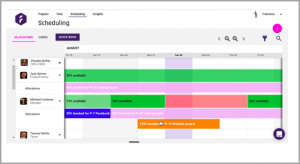Generating new leads is among, if not at the top, of most Marketers priorities, this has not changed. However the professional services marketplace is continuously changing. Every year, more and more companies are finding and vetting potential service firms online. So today, savvy firms are utilizing their websites to not only communicate with their target audiences but also to deliver high-quality leads and nurture prospective clients. In fact, our research shows that firms that generate at least 60% of their leads online grow 4x faster and are 2x as profitable as their competition that doesn’t put emphasis on online lead generation.
Impact of Online Lead Generation on Growth and Profitability

Optimize your website for online lead generation
Your website serves as the central hub of your online presence. It is often the first place people go when they learn of your firm. It should convey who you are, services you provide, i.e. how you can help, and differentiate you form the competition.
To start you will need to “steer” target audiences to your site by implementing appropriate keywords throughout the content of your site. Keywords are specific words or phrases that potential clients are likely to type into a search engine when conducting online research. However it’s not enough to simply steer someone to your website, for online lead generation to be most effective once visitors are on your site you need to meet them where they are in the buying cycle and provide relevant content to engage them and move them further down the sales funnel. Our experience has been that there is a direct correlation between website traffic and the number of conversions and leads a website generates.
Design your site for easy user experience
To effectively guide visitors through your website and generate online leads you must carefully consider the user experience your site presents. Start with clear, compelling messaging on your homepage that quickly allows a visitor to understand how you can help them and what differentiates you from competitors. Be sure to include at least 200 words of search engine optimized (SEO) copy on your homepage and pay special attention to ease of navigation. Your top-level navigation should identify key sections of your site and be labeled in direct, easy to understand terms. There are plenty of opportunities to be creative on your site but your navigation is not one of them. You don’t want to confuse visitors or leave them guessing about where to go to find information that’s of most interest to them. If you have more than one target audience consider implementing pathways to clearly direct each audience to the areas of your site that are pertinent to their specific needs.
Establish a blog to share timely, relevant content
A blog is an important vehicle for supplying a steady flow of informative, educational content which demonstrates your expertise and relevance to your target audience. Allow readers to subscribe to your blog and encourage them to share posts on social media. To further increase online lead generation invite guest bloggers to write for your blog and offer to serve as a guest blogger yourself on other reputable sites to expand your reach and improve your website’s domain authority. Domain authority is numeric score assigned to your website by search engines, it is based on a logarithmic scale of 1-100. The higher your website’s domain authority the higher your site will appear in online searches.
Create compelling, downloadable educational content
In addition to a blog it is advisable to have a resource section or library on your website that includes a wealth of premium content for visitors to download. Premium content is typically longer format than blog posts and delves deeper into specific topics. Your resource section should not include marketing messages or collateral materials. It should include informative, educational content that are beneficial resources for visitors to the site. This is where you will house white papers, executive guides and/or books on topics of interest and relevance to your audience.
Implement simple forms to grow your prospect list
To aid in online lead generation premium content is often placed behind a registration gate, i.e. a short form to collect basic information such as first and last name and email address, which allows for converting interested visitors into leads. You want to keep these forms very short and simple because research shows that the more information you require a visitor to share the less likely they are to complete and submit the form resulting in a negative impact on your conversion rates. Prospects who are willing to submit basic information for content that they perceive as valuable are prime leads. You will want to add them to your prospect list for ongoing marketing outreach.
Offer opportunities to engage more directly
In addition to registration forms for downloadable content, websites that are designed for online lead generation also include targeted offers in various places on the site to further engage visitors. Offers can be for the download of premium content, registration for a webinar/speaking engagement, sign up for a free consultation or a trial period for a particular service. When a prospect responds to an offer this allows your business development team to better assess each lead and how likely they are to convert to an opportunity based on where they are in the sales funnel. A prospect that has reached a level of engagement where they have more direct interaction with your organization through participation in a webinar or a request to schedule a personal consultation is closer to converting to an opportunity than someone who has simply subscribed to your blog. The more direct and personal the interaction the closer you are to closing a deal.
Test, analyze and adjust as needed
Use a client relationship management database (CRM) or website analytics, such as Google analytics, to track visitors history and interaction with your site. What pages do they frequent most? What content have they downloaded? Which offers have they responded to? If you’re not hitting the conversion rates you desire or you just want to see what works best for driving response rates you should regularly test your content and offers by changing headlines or graphics, and be sure that offers are placed where they’re most likely be noticed. Online lead generation requires ongoing maintenance and adjustment but time and time again it has proven to be well worth it to companies that are interested in growing and being more profitable.
Digital & Social Articles on Business 2 Community
(78)




